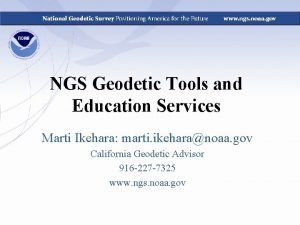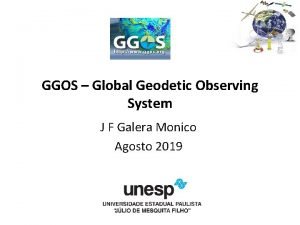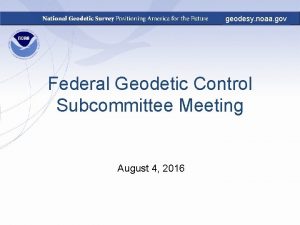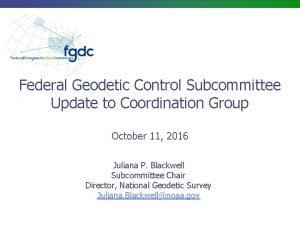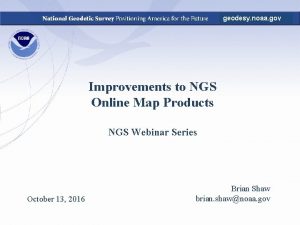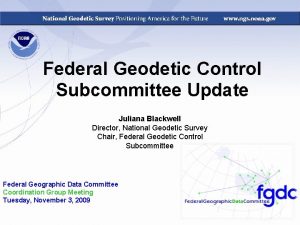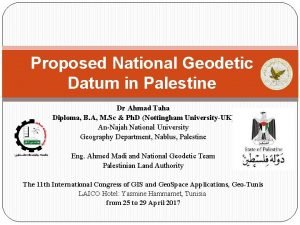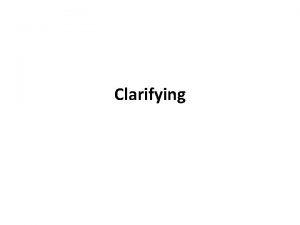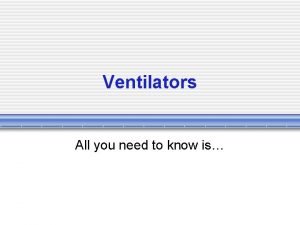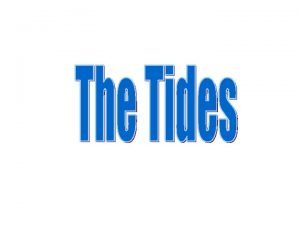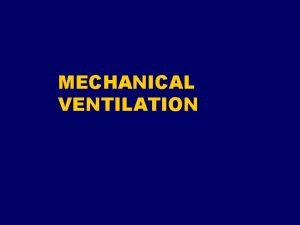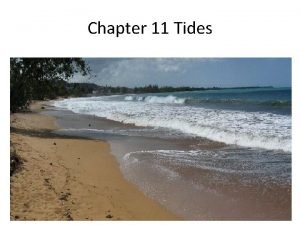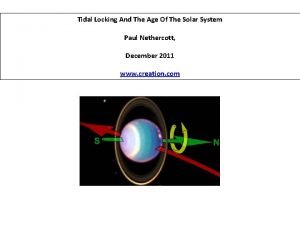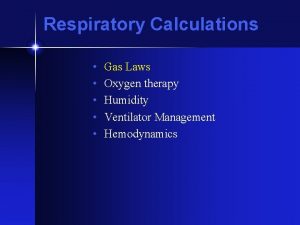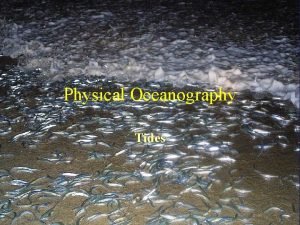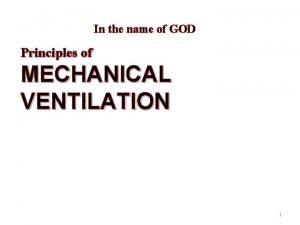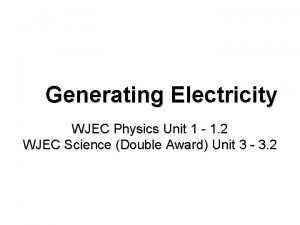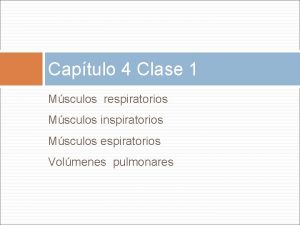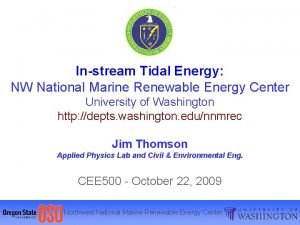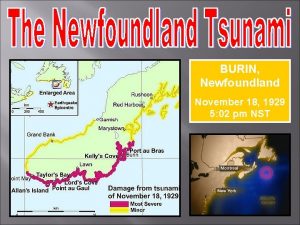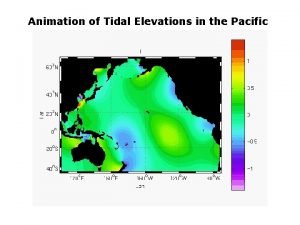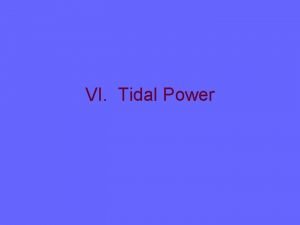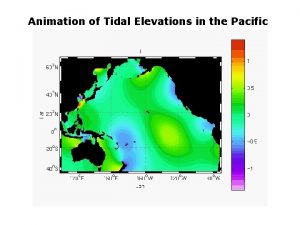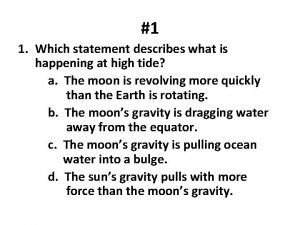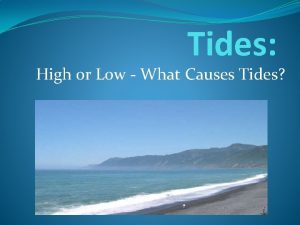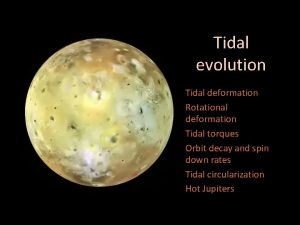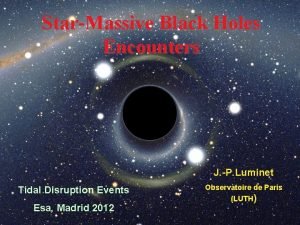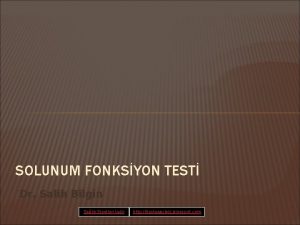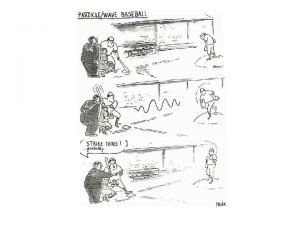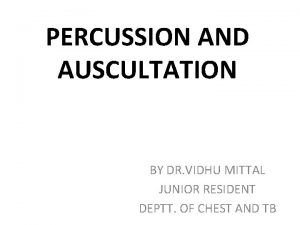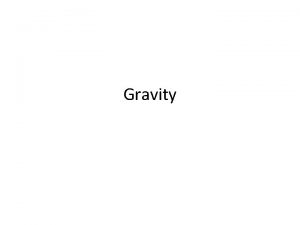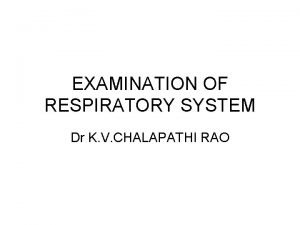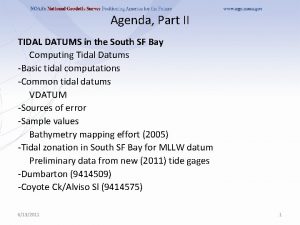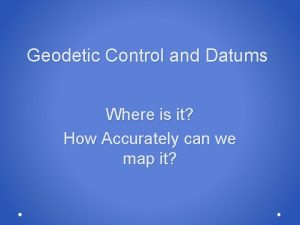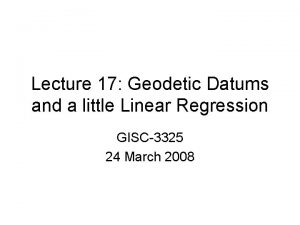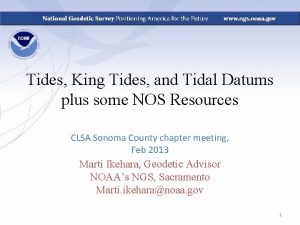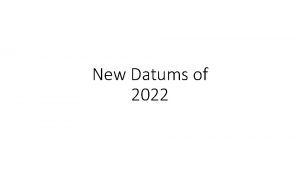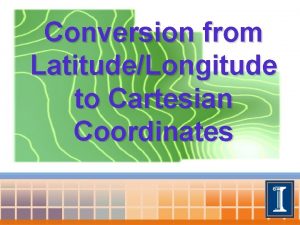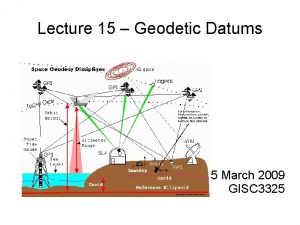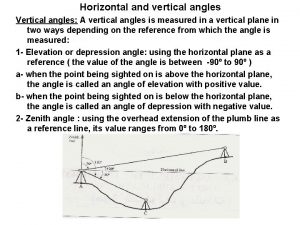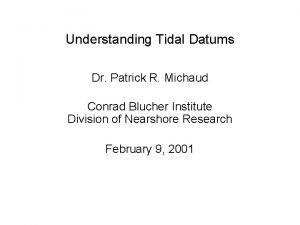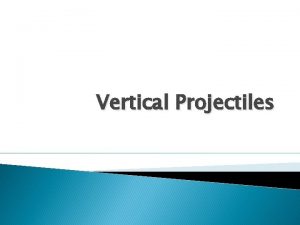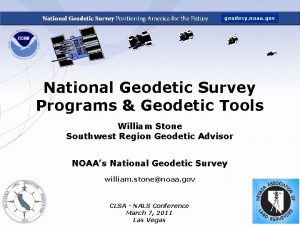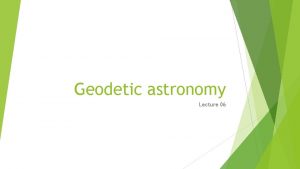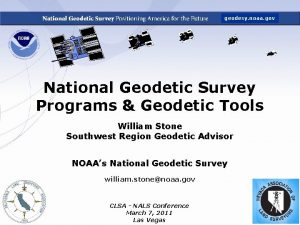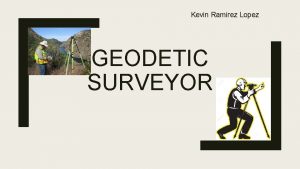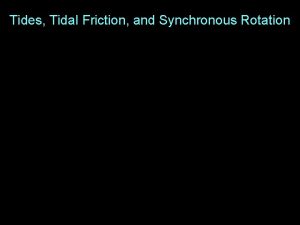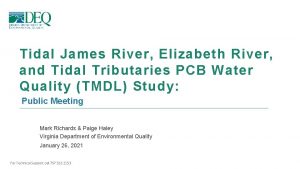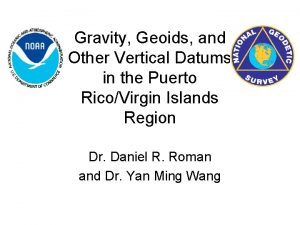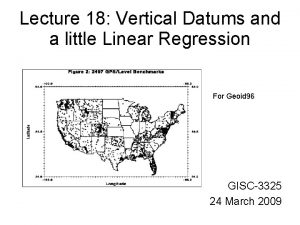Geodetic Vertical and Tidal Datums focus on South

































































- Slides: 65

Geodetic Vertical and Tidal Datums, focus on South SF Bay, CA Marti Ikehara, Geodetic Advisor NOAA’s NGS, Sacramento Marti. ikehara@noaa. gov

Agenda, Part I GEODETIC VERTICAL DATUMS The World According to Garpodesy -Definitions: ellipsoid, datum, reference frame, datum realization, epoch date -Geoid model: What does it do? , Geoid data in California Vertical datums: NGVD 29, NAVD 88 GPS/GNSS Technology -How does it work? Why doesn’t it work sometimes? -RTK versus Static methodology (Height Modernization techniques) -Real world data example from a current Ht Mod project Retrieving Geodetic Vertical Control data Understanding Vertical Control info on an NGS Datasheet -Digit significance, accuracies -Metadata (datum tags, epoch dates) -Superceded data 6/13/2011 2

6/13/2011 3

6/13/2011 4

The World According to Garpodesy • Vertical data now measured with GPS so we must understand GPS (3 -D) coordinate system • Geodesy: study of size & shape of the Earth • Earth is represented by an oblate ellipsoid; the a (axis)radius and flattening parameter 1/f • Ellipsoid utilized by many is GRS 80: Geodetic Reference System of 1980 • World Geodetic System of 1984 (WGS 84) ellipsoid used by DOD for GPS 6/13/2011 5

DEFINITIONS of ELLIPSOIDS USED in U. S. and the datums based on them CLARKE 1866 (NAD 27) a = 6, 378, 206. 4 m 1/f = 294. 97869821 GEODETIC REFERENCE SYSTEM 1980 - (NAD 83) a = 6, 378, 137 m 1/f = 298. 257222101 WORLD GEODETIC SYSTEM 1984 - (WGS 84) a = 6, 378, 137 m 1/f = 298. 257223563

WHAT IS A DATUM? • It is a geographic system for coordinates or heights, so a datum has an origin and/or ‘zero’. • “Underlying” a horizontal or geometric datum system is an ELLIPSOID, that represents the global shape of the earth; a geometric DATUM is the ‘continental’ shape as measured with physical marks (passive or active) that have been related by geodetic surveying • NAD 83 was thought to be geocentric but with addition of GPS data, we found out that it is not

Simplified Concept of NAD 83 vs. ITRF## (or WGS 84) h## h 83 Earth’s Surface IDENTICALLY shaped ellipsoids (GRS 80) eters 2. 2 m NAD 83 Origin ITRF ## Origin a = 6, 378, 137. 000 meters (semi-major axis) 1/f = 298. 25722210088 (flattening)

6/13/2011 9

What is a reference frame? A fundamental (the highest accuracy) geodetic 3 -dimensional coordinate system that includes velocities (dynamic). It can also be a “datum”. ITRF is a global geodetic system that is based on data from continuous GNSS stations. NAD 83 datum, at the national level, is transformed from the ITRF system, and is primarily defined by CORS. The first transform was in 1996. Thus, for OPUS solutions, you will see “Reference frame: NAD 83 (CORS 96). ” 6/13/2011 10

• http: //www. naref. org/transf/nad 83_agu 2007 spr. pdf 6/13/2011 11

Translation, rotation, scale + TIME 6/13/2011 12

Realizations of NAD 83, epoch date • A “realization” is when a major adjustment is done by NGS of the geodetic control, either by state or nationally, resulting in new coordinates and ellipsoid heights, and is identified by a “datum tag”. • Ortho heights are NOT revised. • The realization has different stations in the dataset, and used different control/constraints, and likely different values for them because of crustal motion • There are two types of epoch dates in CA: Reflects the time of the field observations, eg, 2002. 75, or Reflects the time of the recent national adjustment, eg, 2007. 00, or a local adjustment constrained to the national, or a statewide (or large project) adjustment by CSRC 6/13/2011 13

http: //csrc. ucsd. edu: NAD hght, 2011. 00 6/13/2011 14

Ellipsoid, Geoid, and Orthometric Heights H = Orthometric Height (NAVD 88) h = Ellipsoidal Height (NAD 83) N = Geoid Height (Geoid 09) H =h-N H h TOPOGRAPHIC SURFACE N Geoid GEOID 09 Ellipsoid GRS 80/NAD 83

EQUIPOTENTIAL SURFACES


Global Geoid model, satellite data 6/13/2011 18

GEOID 09 compared to GEOID 03 09: teal, good; yellow: State advisor-rejected; red: analysis-rejected 03 (underlying dots): dk blue, kept; orange: rejected

What vertical datums are in use? • • • Orthometric: NAVD 88, NGVD 29 (superceded) Ellipsoid: NAD 83, WGS 84 (4), ITRF## (11) Non-tidal: IGLD 85 TIDAL Island datums (HI, PR, VI, AM, GU, MAR) 6/13/2011 20

The National Geodetic Vertical Datum of 1929 is referenced to 26 tide gauges in the US and Canada

NAVD 88 NGVD 29 Referenced to to 26 1 Tide Referenced Tide. Gauge Gages (Father’s Point) -11 cm 125 cm 85 cm 70 cm 102 cm -23 cm NAVD 88 minus LMSL(1960 -1978) 4 cm -11 cm -23 cm

GPS Technology wrt getting Heights • GPS radio receiver does calculations to determine, for each satellite viewed, the number of integers (ambiguity) of full-phase cycles of the carrier phase of the GPS code embedded on the signal between the satellite and the receiver. • If/when that solution is correct, the calculated distance (range) is correct and triangulation is likely to be correct. 6/13/2011 23

Why doesn’t it ‘work’ sometimes? • Triangulation works best when the knowns are well-distributed not clumped. • No signals can come from ‘below’ the unknown point so all the calcs are from above • WEAK signal coming from 24 K km above • Error fr: Ground, Air, Equipment 6/13/2011 24

SOURCES OF ERROR in GPS SIGNAL RECEPTION

SUNSPOT CYCLE WWW. SWPC. NOAA. GOV • • • Sunspots normally follow a regular 11 year cycle We are on the rising leg of the current cycle Sunspots increase the radiation hitting the earth's upper atmosphere and produce an active and unstable ionosphere

The next solar cycle will be below average in intensity, with a maximum sunspot number of 90. Given the predicted date of solar minimum and the predicted maximum intensity, solar maximum is now expected to occur in May, 2013. 6/13/2011 27

Disruption/jamming/interference • From Sea Surveyor’s report for tide gage installation: During collection of soundings along the eastern shoreline of South San Francisco Bay, an unknown microwave source (possibly radar from Oakland International Airport) occasionally disrupted the differential corrections being received aboard the survey vessel. The field survey crew found that placing metal shielding on the north side of the differential GPS antenna eliminated the microwave disruptions. • Military airborne or airport operations can interfere. 6/13/2011 28

SV 20 SV 14 Different Phase Patterns Antenna Type A Antenna Type B Note that SV elevation and varying phase patterns affect signal interpretation differently

RTK technology/methodology • Limited to 10 -20 km because ionosphere changes enough that correction may be wrong • Horizontal calcs from triangulation are/can be good but vertical is much harder • 3 signals at risk: each GPS unit, and correction • PRECISION can be very good, but ACCURACY not as likely – Darts clustered in triangle 1, but aiming for 20 – Darts scattered but evenly distributed fr bullseye • Redundancy is always key; for vertical, it is crucial • Repeat measurement with a different satellite constellation 6/13/2011 30

Height Modernization procedures, “Long Static” • Dual-frequency rx, fixed height poles • Redundancy: EVERY baseline observed twice • DIFFERENT TIME OF DAY, >3 hours difference – This assures accuracy not just precision because it uses a new set of satellites (an independent obs) • • 45 (minimum)-60 (preferred) minutes--not 30 Local stn spacing average 7 km, <10 km Difference in B 1 and B 2 <2 cm (25 mm) 3 sessions of 5 hours on stns at 40 km spacing 6/13/2011 31

Real world data, Delta Ht Mod project • A baseline has an ellipsoid height difference between two stations • A comparison is made between two (at least) observations made on dif days at dif time of day • They should agree to within 2 cm (<26 mm) 6/13/2011 32

20 cm 10. 5 8. 4 Why SO bad? 6. 9 5. 1, 1. 6 4. 3, 2. 3 4. 0, 2. 4 6/13/2011 33

6/13/2011 34

6/13/2011 35

NGS Vertical Geodetic Control 6/13/2011 36

Retrieval options, ASCII text (or shapefiles) 6/13/2011 37

6/13/2011 38

6/13/2011 39

6/13/2011 40

Visualization of NGS Geodetic Control • CA Geodetic Advisor Resources (CGAR) website, hosted by CT Office of Land Surveys webpage http: //www. dot. ca. gov/hq/row/landsurveys/ geodetic – Google Earth kmls – Google Maps online – Shapefiles • DSWorld, NGS partner software (shows ALL control; doesn’t symbolize VERTCON differently)

http: //www. dot. ca. gov/hq/row/landsurveys /geodetic_control. html


6/13/2011 44

6/13/2011 45

6/13/2011 46

6/13/2011 47

6/13/2011 48

PROTECT this mark at all costs or transfer elevation to something (else) “permanent” or both! 6/13/2011 49

http: //csrc. ucsd. edu/projects/pgm/ cenchm 2007. html 6/13/2011 50

Search option: Name includes ‘ 941’ PID format: AA####: HAS leveled ht; may be NGVD 29 AAAA##: NOT in old NGS database, so no geodetic ht 6/13/2011 51

6/13/2011 52

• Shown to cm • No Ht. Mod note at top • METADATA is to be read! 6/13/2011 53

GPS derived orthometric heights for airport stations designated as PACS or SACS are published to 2 decimal places. This maintains centimeter relative accuracy between the PACS and SACS. It does not indicate centimeter accuracy relative to other marks which are part of the NAVD 88 network. 6/13/2011 54

6/13/2011 55

6/13/2011 56

OPUS-DB, 8/16/07: eh: -29. 644 +/-2. 6 cm; o. H: 2. 855 +/-10. 8 cm GEOID 03 6/13/2011 57

OPUS-DB, 1/19/11: eh: -29. 643 +/-2. 6 cm; o. H: 2. 917 +/- 5 cm GEOID 09 6/13/2011 58

-29. 599 +/-. 96 cm; 2. 95= -29. 539 + GEOID 03 (LSA) 6/13/2011 59

ORTHO HEIGHT COMPARISONS Eht datum tag: 1)NAD 83(1998); 1 a)NAD 83(2007); 2 and 3)NAD 83(CORS 96) 1. Published Datasheet, 2002. 75 epoch(superceded) for the orthometric ht adjustment -29. 539 – (-32. 499) ≈[2. 96]: 2. 95± 5 cm 1 a. [-29. 599 ± 0. 96 cm --current eht] 2. OPUS-DB, 8/16/07 -29. 644 ± 2. 6 cm -32. 499 [G 03] 2. 855 ± 10. 8 cm 3. OPUS-DB, 1/19/11 -29. 643 ± 2. 6 cm -32. 56 [cur ght] 2. 917 ± 5 cm 6/13/2011 60

• • • SUMMARIZE Geodesy: representing the Earth and defining a system for coordinates and heights GPS Technology: difficult to get heights Real-world data, errors up to 20 cm! Where to get NGS vertical control Interpreting quality, age of data reading metadata on NGS Datasheets BREAK! 6/13/2011 61

Utilization of ‘heights’ from NGS • NGS adopting new reference frame for CORS, the active component of NSRS, this July: IGS 08 (2011), epoch 2005. 00 • National adjustment of passive component of NSRS by year end (we hope): NAD 83 (2011), epoch 2010. 00 • Ellipsoid hts will change again, but NOT ortho • Because GEOID models keep changing, can I just look at and compare ellipsoid heights over the years? They are not directly comparable because of the different datum tags and different scope and constraints (fixed stations) in each project. 6/13/2011 62

6/13/2011 63

6/13/2011 64

Agenda, Part II TIDAL DATUMS in the South SF Bay Computing Tidal Datums -Basic tidal computations -Common tidal datums VDATUM -Sources of error -Sample values Bathymetry mapping effort (2005) -Tidal zonation in South SF Bay for MLLW datum Preliminary data from new (2011) tide gages -Dumbarton (9414509) -Coyote Ck/Alviso Sl (9414575) 6/13/2011 65
 Porter's competitive strategies
Porter's competitive strategies Two fundamental business strategies are
Two fundamental business strategies are For adult
For adult Actor focus vs object focus
Actor focus vs object focus State geodetic administration
State geodetic administration Ngs geodetic toolkit
Ngs geodetic toolkit Teropong pendatar tangan adalah
Teropong pendatar tangan adalah Global geodetic observing system
Global geodetic observing system Canadian geodetic datum
Canadian geodetic datum Federal geodetic control subcommittee
Federal geodetic control subcommittee Federal geodetic control subcommittee
Federal geodetic control subcommittee Ngs cors
Ngs cors Federal geodetic control subcommittee
Federal geodetic control subcommittee Geodetic
Geodetic Old south vs new south streetcar named desire
Old south vs new south streetcar named desire Single basin and double basin tidal power plant
Single basin and double basin tidal power plant Pros of tidal energy
Pros of tidal energy Tidal energy pros and cons
Tidal energy pros and cons Wave and tidal power
Wave and tidal power Tidal stream generator
Tidal stream generator Tidal volume per kg
Tidal volume per kg Tidal current
Tidal current Tidal resource
Tidal resource Tidal volume per kg
Tidal volume per kg Tidal volume calculation
Tidal volume calculation Tidal energy ltd
Tidal energy ltd Tidal energy environmental impact
Tidal energy environmental impact Tidal heating
Tidal heating Diurnal tide cycles occur ______.
Diurnal tide cycles occur ______. Calculate tidal volume by height
Calculate tidal volume by height I'tidal adalah
I'tidal adalah Tidal lock
Tidal lock Ryan saad
Ryan saad Largest tidal ranges in the world
Largest tidal ranges in the world Pituitaria roja dibujo
Pituitaria roja dibujo Normal lung compliance
Normal lung compliance The sagittarius dwarf tidal stream
The sagittarius dwarf tidal stream Site:slidetodoc.com
Site:slidetodoc.com Low tide causes
Low tide causes Weaning parameter
Weaning parameter Tidal energy pdf
Tidal energy pdf Tidal trust algorithm
Tidal trust algorithm Volumen tidal
Volumen tidal Tidal energy
Tidal energy Single pool tidal system
Single pool tidal system Cominstream
Cominstream Tidal wave newfoundland
Tidal wave newfoundland Tides animation
Tides animation Tidal power definition
Tidal power definition Tidal volume
Tidal volume Tidal energy animation
Tidal energy animation Which statement describes what is happening at high tide
Which statement describes what is happening at high tide Spring tides occur when
Spring tides occur when Tidal
Tidal Tidal heating
Tidal heating Luminet black hole
Luminet black hole Solunum paternleri
Solunum paternleri Severn tidal power feasibility study
Severn tidal power feasibility study Tidal deposits
Tidal deposits Tidal force
Tidal force Percussion note lungs
Percussion note lungs Tidal volume
Tidal volume Exercise 24 review sheet respiratory system physiology
Exercise 24 review sheet respiratory system physiology Tidal
Tidal Tidal bulges
Tidal bulges Bronchophony
Bronchophony





